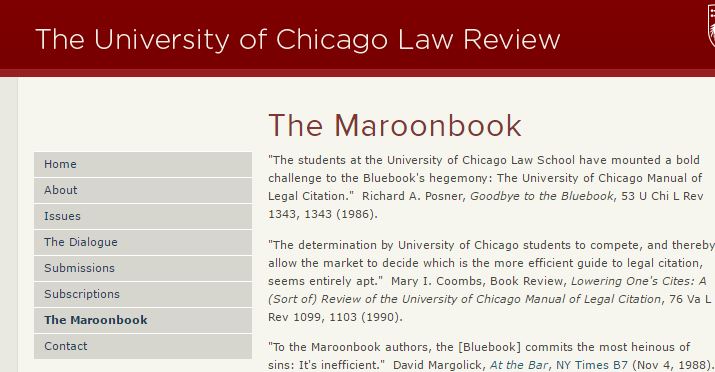Past posts have noted many points of divergence between the citation norms manifest in most judicial and lawyer writing and The Bluebook‘s dictates. They include such matters as case name abbreviations, the identification of a writer’s online source for cited primary authority, the format and content of treatise citations, and inclusion of a currency date in citations to statutes or regulations. The Bluebook‘s continued reign over law journal commentary and programs of instruction on professional writing in U.S. law schools has largely been taken for granted. Its dominance within the legal academy is undeniable.
Ten years ago Professor Ilya Somin of George Mason explained that dominance in terms of market failure. He argued that it was primarily a result of the decision’s being made by short-termers, student board members at a time they no longer bear the cost of compliance and who, having previously mastered The Bluebook‘s arcane rules, derive some satisfaction from imposing them on their successors as a form of hazing. In a companion Bluebook critique Professor Somin noted that The University of Chicago Law Review had, without evident loss of quality or prestige, employed a simpler and more rational citation scheme ever since 1986.
Today that journal still follows its own citation guide, the “Maroonbook.” The University of Chicago manual is not a rule-for-every-situation guide. It aims, instead, to establish a framework for citation, in which general principles of sufficiency, clarity, consistency, and simplicity operate. In length it runs to 85 pages compared to The Bluebook‘s 560.
Now, in 2016, comes another law journal breakaway with an even more radical rejection of Bluebook rules and specificity. The citation guide released this week by The Berkeley Journal of Gender, Law & Justice consists of a mere six pages of principles and examples. The student editorial boards of other law school-based journals would do well to consider the reasons listed as propelling this change. The first cited by the Journal of Gender, Law & Justice is the barrier that Bluebook compliance places in front of both scholars from other disciplines and practicing lawyers, thereby privileging the work of a relatively small group of authors. Those the requirement favors, of course, are legal academics, who by virtue of background, resources (in the form of student assistants), or both can conform their references to Bluebook mandates. A second reason cited is the costly diversion of editorial time and effort away from attention to an article’s substance in order to scrutinize and perfect the format of its footnotes. Lastly, the editors express concern about the the difficulty for readers, particularly those situated outside the legal academy, posed by the Bluebook‘s terse encoding of journal names. (They employ “J. Mar. L. & Com.” as an example.)
Will others likely follow? The process of article submission has moved online. Rarely, today, are articles prepared for and submitted to a single journal. Using services like Expresso and Scholastica most law faculty members submit their scholarly writing to multiple journals at once. The vast majority of those journals require citations of submitted manuscripts to be in Bluebook form. This adds a powerful network effect to the factors of market failure cited by Prof. Somin and the prestige and strength of The Bluebook brand. As sound a decision as The Berkeley Journal of Gender, Law & Justice has made, it seems unlikely to foreshadow a large scale exodus of journals through The Bluebook‘s force field.

